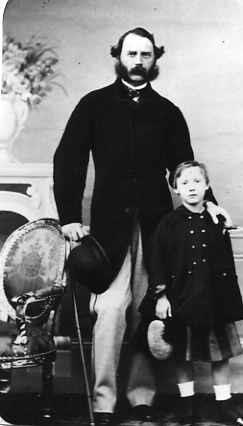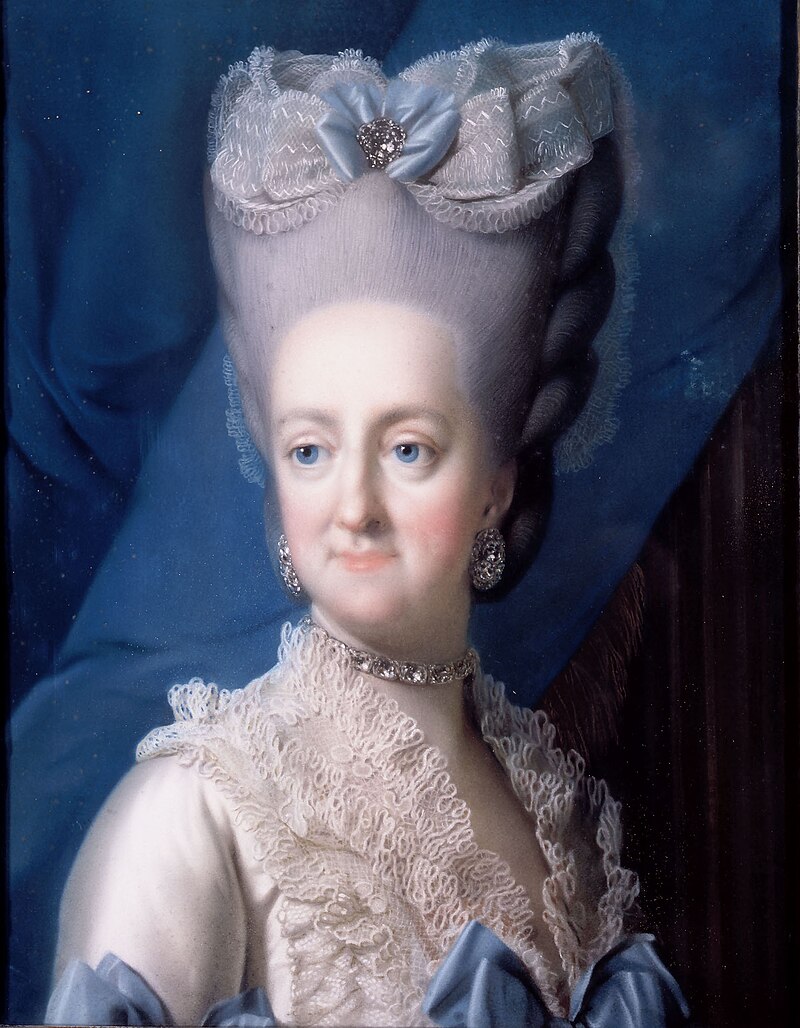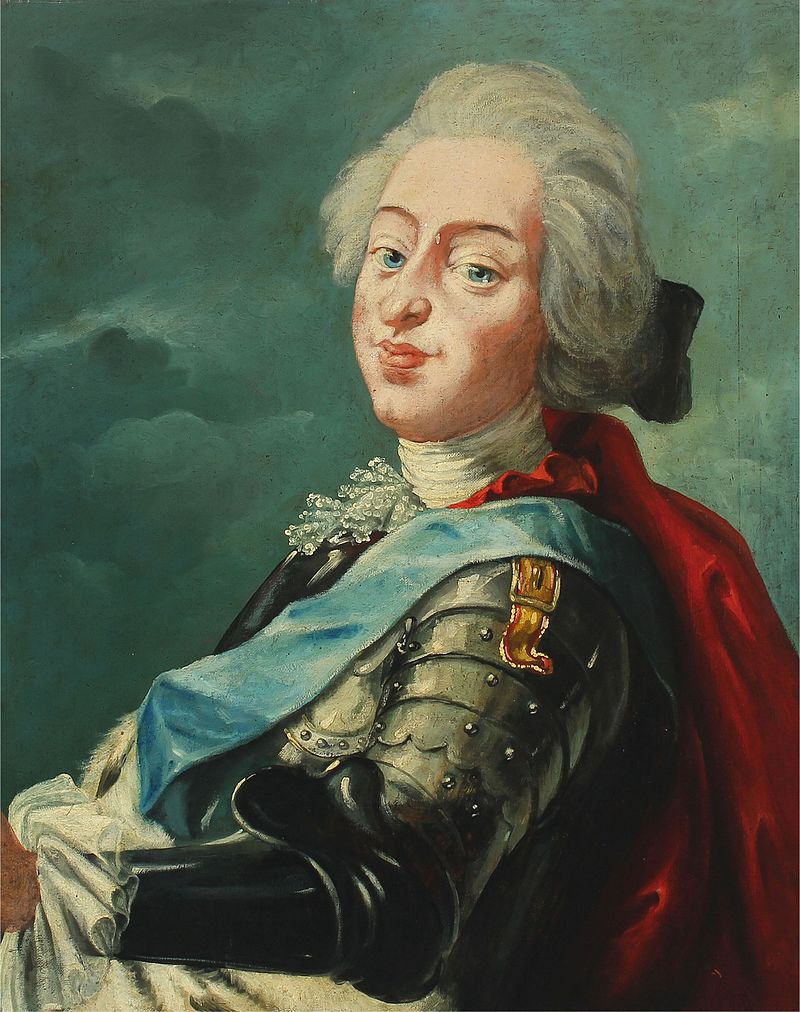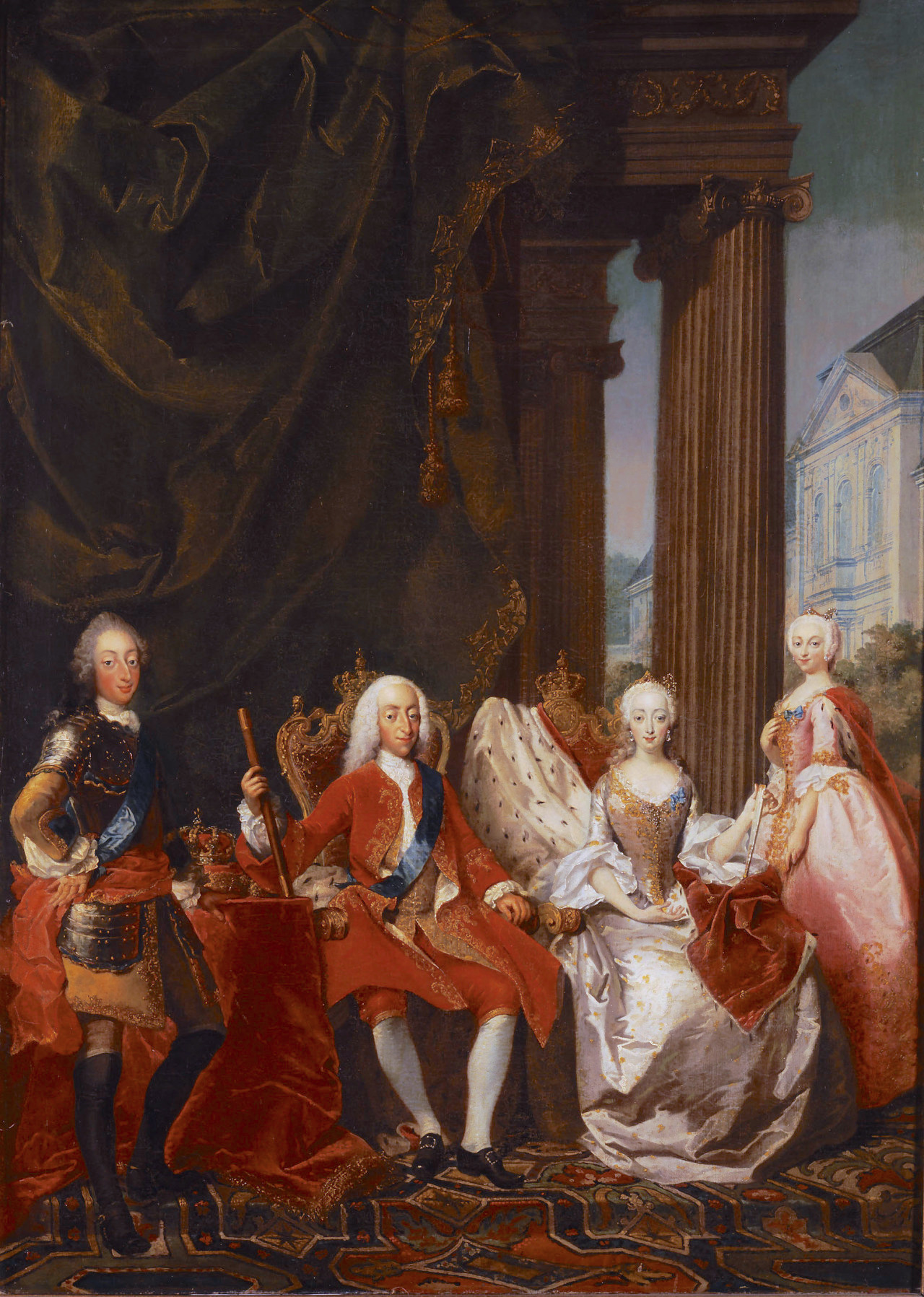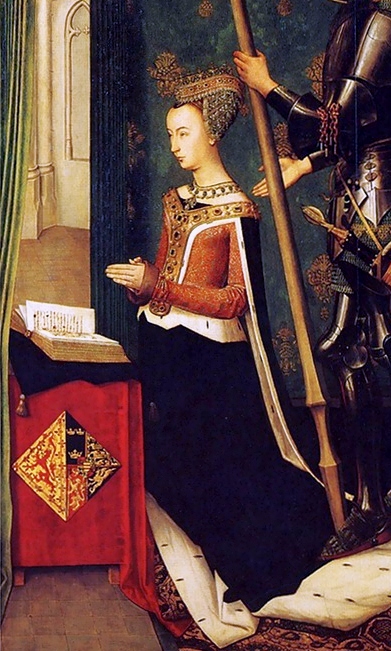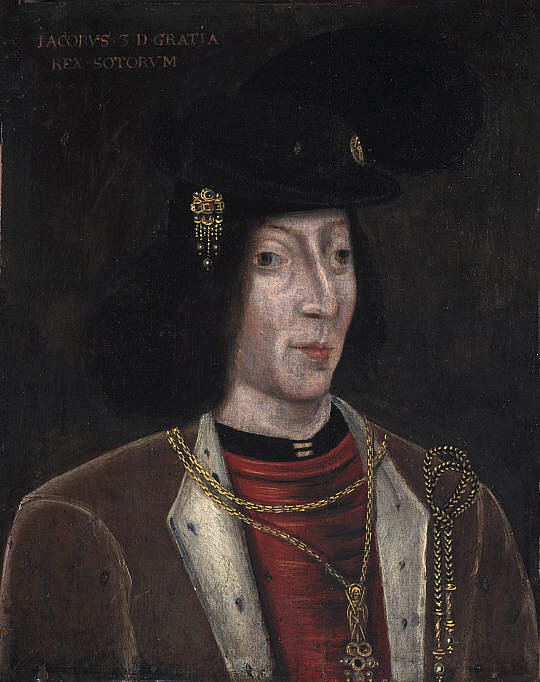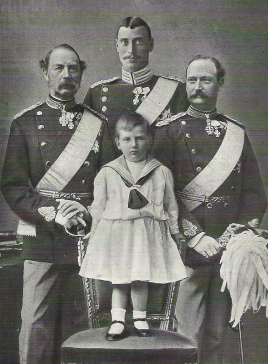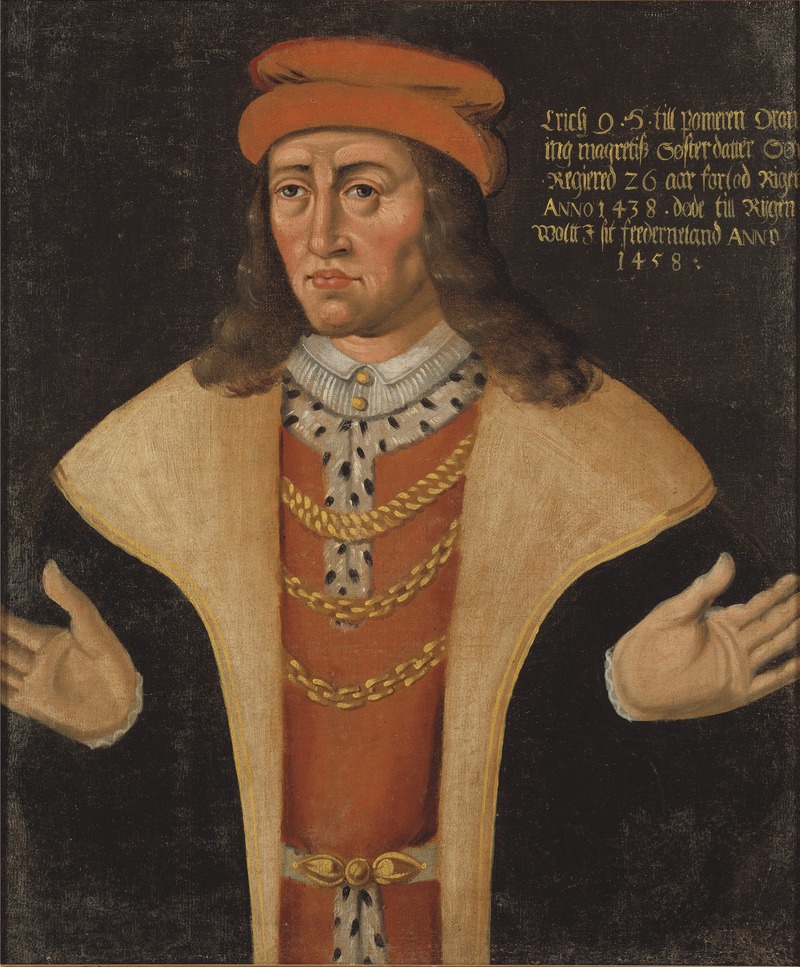by Emily McMahon © Unofficial Royalty 2017
Princess Margrethe of Denmark (the future Queen Margrethe II of Denmark) and Count Henri de Laborde de Monpezat were married on June 10, 1967, at Holmens Kirke in Copenhagen, Denmark. Each video below is between four and seven minutes.
Margrethe’s Early Life

Margrethe (right) with her sister Benedikte, c. 1946. Credit: nordic-aputsiaq.blogspot.com
Margrethe Alexandrine Thorhildur Ingrid was born at Copenhagen’s Amalienborg Palace on April 16, 1940, the eldest of three daughters of King Frederik IX of Denmark and his Swedish wife, Ingrid. Named for her deceased maternal grandmother, Crown Princess Margaret of Sweden, Margrethe was also the name of the first queen regnant of Denmark and engineer of the long-running Kalmar Union. Young Margrethe also carried the names of her paternal grandmother, mother, and, uniquely, an Icelandic name. As she was born just a week after the German invasion of Denmark during World War II, Margrethe was known from birth as “the ray of sunshine in occupied Denmark.”
After it became clear that Ingrid and Frederik would not have a son, preparations were made to enable Margrethe to rule Denmark after her father. The 1953 Danish Act of Succession allowed daughters to succeed to the throne in the absence of direct male heirs. Although Margrethe was released from school the day the act was passed to celebrate, Ingrid was required to phone her daughter’s teacher to request permission.
Margrethe attended the North Foreland Lodge (a girls’ boarding school) in Hampshire, England, for a year. Her parents purposely selected a school that catered to the middle class so Margrethe would spend time with ordinary girls. Margarethe had a varied experience in higher education, studying at Girton College at Cambridge University, Aarhus University, the Sorbonne, the London School of Economics, and the University of Copenhagen. Margrethe later said on several occasions that she particularly enjoyed the anonymity that came with studying outside of Denmark.
A gifted linguist, Margrethe became fluent in Danish, Swedish, French, German, and English. On a visit to the Faroe Islands, Margrethe was even able to converse in decent Faroese. She also enjoyed cooking – which she often did herself as a student – but lamented that she had little time to devote to it. Margrethe also enjoyed visual art, and her paintings, drawings, and costumes would later be used and displayed in various exhibitions and productions after she became queen.
Although she studied a variety of subjects, Margrethe was always drawn to archeology. She developed a love of the discipline from a young age, possibly because her maternal grandfather Gustav VI of Sweden taking her along on expeditions in Italy when she was a child. Before she became queen, Margrethe had assisted on expeditions in Thailand, Egypt, and Sudan.
Margrethe also served in the Women’s Auxiliary Air Corps in her young adulthood, where she became an able markswoman. She also took lessons in jiu-jitsu and judo and excelled at the high jump, swimming, and tennis. Shortly after her 18th birthday in 1958, Margrethe began serving as regent during her father’s occasional absences from Denmark. She attended her first opening of the Danish Parliament in October 1958.
For more information about Margrethe see:
Unofficial Royalty: Queen Margrethe II
Henri’s Early Life
Margrethe, Henrik, Mary, and Frederik in front of Henrik’s childhood home in Hanoi, Vietnam
Henri was born on June 11, 1934, in Talence, France. His parents, Count André de Laborde de Monpezat and Renee Doursenot, were members of the French nobility. Renee had previously been civilly married to another man before her marriage to Andre; her first marriage allowed Renee to marry Andre religiously in 1934, but the couple did not marry civilly until 1948. Henri had six siblings, including a sister who died in childhood.
Henri began his education at home with a private tutor and continuinued his education at a Jesuit school in Bordeaux, France. Henri spent several years of his childhood in Vietnam, then under French control, where his father ran a newspaper. He attended a French school in Hanoi, where he took interest in Vietnamese and Chinese languages.
Henri’s love for Southeast Asia continued into his adolescence and adulthood, as he continued his education at schools in Saigon and Hong Kong. Henri studied political science at the Sorbonne, as his wife did years later. He also studied at Paris University, earning a master’s degree in French literature. Henri was awarded a diploma in Oriental languages from Ecole Nationale de Langues Oriental before serving in the French military in Algeria.
After his time in the military, Henri entered the French foreign services. In 1963, he began working at the French embassy in London. At the time he met Margrethe, Henri was working as the third secretary in the Department of Oriental Affairs at the embassy.
Henri’s developed a wide variety of interests ranging from flying planes to collecting Chinese porcelain to sailing. Like his future wife, Henri was multi-lingual from early on. In addition to French, Danish, and English, Henri speaks fluent Mandarin Chinese and Vietnamese.
For more information about Henrik see:
Unofficial Royalty: Prince Henrik of Denmark
“He came, he saw, you conquered.”

Henri and Margrethe, c. 1966. Photo credit: bimg.dk
When asked once by a journalist as a young woman when she would find her husband, the amused Margrethe replied, “Wouldn’t it be fairer to ask when will he be finding me?” Margrethe had no way of knowing that her husband would indeed find her rather than the other way around. Before her engagement, Margrethe also confirmed during an interview with the press that the Danish constitution would not have to be amended if she were to marry a commoner.
While studying at the London School of Economics in 1965, Margrethe was invited to a dinner at the French embassy. As an employee of the embassy at the time, Henri was expected to attend but was ambivalent about meeting the Danish princess by whom he was to be seated. Henri later said that to his surprise he found Margrethe interesting from their first meeting, but was a bit intimidated by her and said little during the dinner as a result. Margrethe said she had no real impression of Henri from their first meeting.
Margrethe and Henri were both guests at a wedding shortly after the first dinner. The two chatted at the wedding reception and on the plane ride back to London, as they were seated together once again. Upon their return to London, Margrethe and Henri gradually began seeing more and more – and growing mutually fonder – of one another.
The couple kept a low profile for more than a year, made easier by Margrethe’s anonymity in Britain. The couple was so private that upon the news that an engagement announcement was imminent, most Danes had no idea their princess had been exclusively dating anyone. Frederik was later to say to his daughter of her courtship with Henri, “He came, he saw, and you conquered.”
The Engagement

Henri and Margrethe on the balcony of Amalienborg Palace when their engagement was announced. Photo credit: dr.dk
Margrethe received from Henri a Van Cleef and Arpels engagement ring featuring two large square-cut diamonds set at a diagonal. Set on a yellow gold band, the diamonds were said to be six karats each.
On October 4, 1966, the Danish Parliament gave their approval of the marriage. It was noted that even the Socialist members consented to the marriage with the message that this did not indicate their approval of the monarchy in general. Upon approval of the marriage by Parliament, Danish Prime Minister Jens Otto Krag wished the couple luck and a happy marriage on behalf of the public.
The following morning, King Frederik VIII formally asked the State Council for approval of the marriage of the heir to the throne. The approval was granted as expected. Henri and Margrethe took a group photo with Frederik and members of the State Council following the decision.
In celebration of parliamentary and state council approval of their marriage, Margrethe and Henri appeared on the balcony at Amalienborg with both sets of parents. A crowd of 5,000 happy Danes had gathered to cheer for the couple. Margrethe told that crowd that she and Henri “shall never forget this day,” while Henri expressed his appreciation in Danish with the words, “Thank you a thousand times.”
After the balcony appearance, Frederik drove his daughter and her fiancé around Copenhagen in an open car to wave at the spectators. The trip ended at Fredensborg Palace, where lunch and a press conference were held. During the press conference, Henri repeated his thanks to the Danish people, remarking that he planned to become one “hundred percent Dane” following his marriage. A banquet for the families and government officials was held that same evening, along with a private orchestra performance. King Frederik VIII, an able conductor, conducted the performance which was later broadcast on Danish radio.
Wedding Preparations

Margrethe and Henri during their engagement. Photo credit: newroyaldaydiscussion.blogspot.com
When the engagement was initially announced, it was speculated the wedding would take place on May 24, the wedding anniversary of Margrethe’s parents. The ceremony was originally scheduled to take place on May 25, 1967, but was later postponed to June 10, 1967, due to Margrethe’s sister Anne Marie’s pregnancy. Anne Marie gave birth to Crown Prince Pavlos on May 20. The religious ceremony was scheduled to take place at Holmens Kirke in Copenhagen, which was at one time a naval blacksmith’s workshop. Margrethe was also baptized at Holmens Kirke.
Erik Jenson, Bishop of Aalborg, would conduct the religious service. Bishop Jenson also formally received Henri into the Danish Folk (Lutheran) Church. Following the wedding, Henri would now be known by the Danish version of his name (Henrik) and convert from Roman Catholicism to the Danish Folk Church.
On Margrethe’s insistence, there would be no special ceremonies at the church marking a royal wedding. The ceremony would last approximately 20 minutes and consist of the same rites and practices as any other Danish wedding. When asked if Henri would say his vows in French, Bishop Jensen replied that as this would be a Danish wedding, all vows would be said in Danish.
Arrangements for twelve days of receptions, galas, tours of Copenhagen, and theater performances were made for guests. The wedding was paid for entirely by the royal family and private donations. Preparations were made to televise the wedding – a somewhat new phenomenon – in Denmark, France, Belgium, Switzerland, Sweden, and Norway.
Although Margrethe’s and Henri’s pairing attracted little controversy in Denmark, the European anti-royalist Provos threatened to throw ketchup at the royal coach during the processional and release mice in the church. The group had also been responsible for numerous demonstrations, fights, and had thrown smoke bombs during the wedding of Princess Beatrix and Prince Claus of the Netherlands in 1966. Additional police officers from around Denmark were brought to the capital to assist with security.
Festivities in Copenhagen and the Bornholm Deer
In the weeks of early wedding planning, the residents of the Danish island of Bornholm contacted Frederik with a unique proposal to feed the guests at the upcoming wedding. At the time, the island had a considerable overpopulation of deer. In hopes of reducing the herd, the islanders proposed that the wedding menu include venison and invited Frederik (an avid hunter) and his entourage to the island. Frederik took up the Bornholm residents’ offer and in a few days’ time was able to kill enough deer to feed several hundred guests.
Henri arrived in Copenhagen at the end of May in preparation for the wedding celebrations. Like her mother had done before her marriage to Frederik, Margrethe drove to the airport and picked up her fiancé on her own. The couple and the Danish royal family attended a banquet that evening with various diplomats attending the wedding. During the first few days after Henri’s arrival, Margrethe and Henri attended numerous sporting events, concerts, and a special reception was held to thank those who helped with the wedding arrangement, planning, and decoration. Henri also quietly converted from Roman Catholicism to the Danish Lutheran Evangelical Church during this time.
The wedding coincided with Copenhagen’s 800th-anniversary celebrations, making the decorations all the more festive. The streets of Copenhagen were decorated with flowers and Danish and French flags. Crowds followed Margrethe and Henri at nearly every stop and event celebrating the coming wedding.
Henri, Margrethe, and the King and Queen attended a reception at the Copenhagen City Hall the day before the wedding. Copenhagen Mayor Urban Hansen and other city officials toasted the couple and wished them a happy marriage before presenting Henri and Margrethe with a set of china.
Before boarding the Danish royal yacht (the Dannebrog) for a tour of the Copenhagen harbor, Henri addressed a crowd of several thousand Danes who had gathered to watch the event. Speaking in Danish, Henri gave his appreciation to the Danish public for their kind reception and well-wishes. The speech was broadcast in Denmark by radio and television. The Dannebrog was flanked by not only several Danish Royal Navy ships but a few Swedish and Norwegian vessels as well. Several Royal Danish Air Force planes flew over as the couple cruised the harbor, their trails spelling out Henri’s and Margrethe’s initials.
King Frederik and Queen Ingrid held events in celebration of the couple nearly every night in the week preceding the wedding. The Copenhagen Royal Theater also gave a special performance to entertain visiting royal guests, in which Frederik and Ingrid lent their theater box to their daughter and her fiance. Additional events included a ball at the French Embassy and a dinner and dance at Fredensborg for the couple and their close friends.
Margrethe’s sister Benedikte and her fiancé, Richard of Sayn-Wittgenstein-Berleburg, greeted most of the royal guests at the airport. Many of the royal guests stayed at Fredensborg Palace (the summer residence of the royal family), or at Storekro, north of the city.
The Wedding Ceremony
The wedding was held in the late afternoon of June 10, 1967, with the majority of wedding guests leaving Amalienborg between 3:30 and 4:30. The wedding procession started at Amalienborg Palace and stretched all the way to Holmens Kirke. Two thousand police officers were assigned to watch the streets along the procession out of concern for anti-royalist protests. Crowds lined the streets of the entire parade route as royal hussars led Margrethe and Frederik, who were traveling in a state coach. Father and daughter waved to the crowd as they passed.
Upon arrival at Holmens Kirke, Margrethe was helped out and her train and veil straightened by her bridesmaids. Margrethe and her father entered to the song “Sicut Cervus,” a sixteenth-century hymn of Psalm 42. Henri smiled as Frederik led his eldest daughter down the aisle of Holmens Kirke, which had been decorated with white and purple bouquets of flowers.
When she reached the altar, Margrethe leaned in as Henri planted a kiss on her cheek. The ceremony was brief for a royal wedding, but typical for such services in the Danish Lutheran Evangelical Church. Along with the couple’s exchange of vows and a sermon, the congregation sang two hymns. Margrethe admired the ring after Henri placed it on her finger, then turned around to give a smile to her parents.
As the wedding ceremony ended, the new couple turned to bow and curtsey to the King and Queen as the bridesmaids again straightened Margrethe’s train and dress. Margrethe and Henri exited the church to “Toccata from Symphony No. 5” amid a 21-gun cannon salute, crowds of spectators throwing confetti and rice, and the bells of Holmens Kirke ringing around them. A 252-gun salute was fired at the close of the service, accompanied by a group of jets forming the letters “M” and “H” in the sky over Copenhagen. Margrethe gave Henri a daisy from her bouquet as the couple climbed into the coach to head to Amalienborg.
The Wedding Attire

Margrethe (and her long train!) with Henri on their wedding day. Photo credit: orderofsplendor.blogspot.com
Margrethe’s dress was designed by Danish dressmaker Jørgen Bender, who was well-known in the Danish royal court. The close-fitting, long-sleeved white silk gown featured a square neckline and deep pleats at the hips, creating a flared skirt. On the front of the dress was a piece of heirloom lace that had originally belonged to Margrethe’s grandmother, Margaret of Connaught, the former Crown Princess of Sweden. The 20-foot silk train of the dress fell from Margrethe’s shoulders and featured squared corners similar to the collar.
On the bodice of her dress, Margrethe also wore another favorite from her mother’s family – the diamond daisy brooch. A nod to Queen Ingrid’s mother (the British Princess Margaret of Connaught, also known as Daisy), this brooch had also been worn by Ingrid on her own wedding day in 1935, a wedding gift from her father. The bridesmaids wore circlets of daisies in their hair, and daisies were the prominent flowers in Margrethe’s bouquet, along with stephanotis.
For her tiara, Margrethe chose the tiara worn by her mother on her wedding day, the Khedive of Egypt Tiara. The Cartier-designed tiara was given to Margrethe’s grandmother Margaret in 1905 as a wedding gift from the Khedive of Egypt. It features numerous diamond laurel leaf swirls anchored at seven peaks with larger diamonds. The Khedive tiara has subsequently been worn by all of Queen Ingrid’s married female descendants on their special days. Attached to the tiara was the veil of point de Venise lace that had also been handed down from Margaret to Ingrid to Margrethe.
Henri wore a classic bridegroom’s attire featuring a black morning coat with cutaways, matching trousers, and a white straight-end bowtie. He also wore the light blue sash and star of the Order of the Elephant, the highest order in Denmark. Henri received the order on the day of the wedding.
After the Ceremony

Henri and Margrethe, dancing their first waltz at the reception. Photo credit: orderofsplendor.blogspot.com
Margrethe and Henri rode in the carriage through Copenhagen, accompanied by 44 mounted hussars. The new couple waved to the crowds flanking the streets along the route, just as the bride and her father had done during the processional. During the recessional, a hussar accompanying the couple was thrown to the ground after his horse bolted, but he was not seriously injured.
The couple appeared on a balcony at Amalienborg Palace with their parents to wave to the crowd of 25,000 below. Frederik thanked the spectators for their enthusiasm and gave his congratulations to the new couple. As Margrethe began to address the spectators, she was overcome with emotion and left the balcony in tears.
A garden reception was held for 400 guests in a pavilion in the courtyard of nearby Fredensborg Palace. The candlelight reception featured a five-course dinner – including the Bornholm venison – catered by the Kesby family of the Richmond Hotel. At the reception, Henri gave a speech to the bride and her family in Danish, again indicating his love for his new wife and adopted country as well as his intention to serve Denmark to the best of his ability. This marked the first public occasion that Henri gave a lengthy speech in his new language.
The bride and groom began the wedding ball by performing their first dance as a married couple, a waltz. After several hours of dancing and talking among their guests, Henri and Margrethe changed to more comfortable going-away attire. The couple said goodbye to their families in the early hours of June 11, boarding the Dannebrog to begin their honeymoon.
The couple honeymooned on the Mexican island of Cozumel, spending part of their time in a villa owned by former Mexican president Adolfo Lopez Mateos. Princess Beatrix and Prince Claus of the Netherlands had stayed at the villa during their honeymoon the previous year.
Wedding Guests and Attendants

Margrethe and Henri with their wedding party and royal guests. Photo credit: orderofsplendor.blogspot.com
The wedding was attended by 900 guests, many whom were royal and prestigious, including three kings, two queens, fourteen princesses, and thirteen princes from around Europe.
One of the most notable absences was King Constantine II and Queen Anne-Marie (Margrethe’s youngest sister) of Greece. 1967 was the year of a coup d’etat in Greece, leaving the family more or less in captivity and unable to travel to Denmark. It was initially believed that Anne-Marie would be allowed to attend alone while the Danish government advised Constantine not to attend, but in the end, neither made it to the celebrations. Ingrid, upset that her youngest daughter and her family would not be present, put up numerous pictures of the couple and their children around the palace during the reception.
The couple had four young teenage girls serve as bridesmaids. The bridesmaids were Kristin Dahl, Countess Desiree of Rosenborg (daughter of Count Flemming), Anne Oxholm Tillisch, and Carina Oxholm Tillisch. Each of the bridesmaids wore short-sleeved blue dresses with circlets of daisies in their hair.
Notable guests included:
- King Frederik IX and Queen Ingrid of Denmark
- King Gustav VI Adolf of Sweden
- King Olav of Norway
- Princess Sibylla of Sweden
- Crown Prince Harald of Norway
- Count and Countess Carl Johan Bernadotte
- Prince Bertil of Sweden
- Count Sigvard and Countess Marianne Bernadotte
- Princess Margaretha of Denmark
- Prince Knud and Princess Caroline-Mathilde of Denmark
- Princess Elisabeth of Denmark
- Prince Ingolf of Denmark
- Count Christian and Countess Alexandra of Rosenborg
- Prince Viggo of Denmark
- Prince George and Princess Anne of Denmark
- Prince Rene and Princess Margrethe of Bourbon-Parma
- Prince Gorm of Denmark
- Count Fleming and Countess Ruth of Rosenborg
- Crown Prince Carl Gustav of Sweden
- Princess Christina of Sweden
- Princess Brigitta of Sweden and Prince Johann Georg of Hohenzollern
- Princess Margaretha of Sweden and John Ambler
- Princess Desiree of Sweden and Baron Niclas Silfverschiold
- King Baudouin and Queen Fabiola of Belgium
- Queen Juliana and Prince Bernhard of the Netherlands
- Crown Princess Beatrix and Prince Claus of the Netherlands
- Grand Duke Jean and Grand Duchess Josephine-Charlotte of Luxembourg
- Prince Louis Ferdinand and Princess Kira of Prussia
- Duke Christian and Duchess Barbara of Mecklenburg-Schwerin
- Princess Marina, Duchess of Kent (the British royal representative)
- President Urho Kekkonen of Finland
- President Ásgeir Ásgeirsson of Iceland
- Prince Richard of Sayn-Wittgenstein-Berleburg
- Princess Benedikte of Denmark
- Prince Juan Carlos and Princess Sofia of the Asturias
- Princess Tatiana Radziwill and Jean Fruchaud
- Captain Alexander Ramsay of Mar (cousin of Queen Ingrid)
- Francoise Bardin (sister of Henri)
- Countess Catherine de Laborde de Monpezat
- Countess Maurille de Laborde de Monpezat
- Count Etienne de Laborde de Monpezat
- Count Jean-Baptiste de Laborde de Monpezat
Children
Margrethe and Henrik had two sons:
This article is the intellectual property of Unofficial Royalty and is NOT TO BE COPIED, EDITED, OR POSTED IN ANY FORM ON ANOTHER WEBSITE under any circumstances. It is permissible to use a link that directs to Unofficial Royalty.




